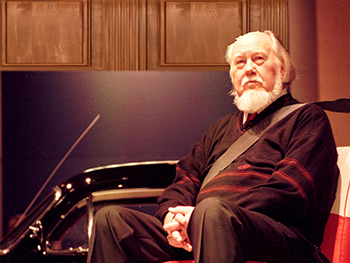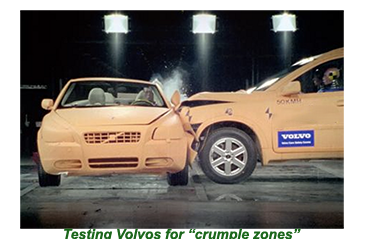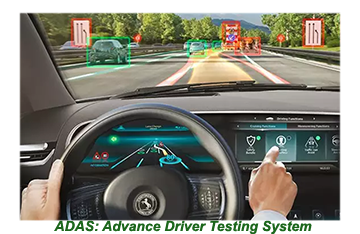 It was only during the Sixties that in-car safety became a remote consideration for most car owners.
It was only during the Sixties that in-car safety became a remote consideration for most car owners.
 The number of cars on the road was growing considerably and with it the number of car accidents.
The number of cars on the road was growing considerably and with it the number of car accidents.
 Seat belts have been around for over a century by that time, with one of the first patents for a restraint system for car passengers dating back to 1903.
Seat belts have been around for over a century by that time, with one of the first patents for a restraint system for car passengers dating back to 1903.
The first patent to be registered belonged to a French engineer named GD Leveau, who experimented with equipping a Renault car with safety belts.
Leveau's seatbelt design crossed in front of the occupant's upper body and were anchored at the top to the seat backrests with the lower anchorage points situated to the left and right of each seat.
In October 1903, Leveau invention was granted a fifteen-year Europe-wide patent.
 Despite their availability and what they offered in terms of car safety the motoring public's imagination remained far from captured.
Despite their availability and what they offered in terms of car safety the motoring public's imagination remained far from captured.
Only in the Fifties, the first safety belts began to be fitted into cars, and even then, only in open-topped coupes and touring cars.
Early safety belts were not comfortable to wear, taking their design mainly from that used in commercial aircraft based around either lap straps or shoulder harnesses and rarely both.
The first significant breakthrough in car safety belt design came in 1958 from Volvo designer Nils Bohlin who developed the first three-point safety belt, which was fitted as standard
After many years of research, Bohlin had recognised the importance of an adequate restraint system using static seat belts with fixed buckles, which were both comfortable and easy to use.
Throughout the Sixties, fixed seat belts found their way into cars of the Sixties, which were also very expensive while effective.
The Sixties saw the development of "inertia-reel" seatbelts, which — thanks to their retractable mechanism ensured that the driver and passengers were allowed sufficient freedom of movement during their journey.
![]()
In contrast, in the event of a collision, the automatic mechanism reacted, locking the belt.
Either attached by a securely fixed bracket or a lap buckle secured to a cable, these automatic belts offered the utmost comfort and could be readily connected with one hand.
Despite the developments, seat belts still failed to catch on. Only intervention from the Vehicle Licensing Authorities in the Sixties and onwards made it compulsory for manufacturers to install a set of preparatory anchorage points in vehicles produced from 1965 onwards.
 The requirement to fit three-point belts in the front outboard positions came three years later.
The requirement to fit three-point belts in the front outboard positions came three years later.
The same 1968 legislation also made it compulsory for all new vehicles to be fitted with a complete set of front seat belts while requiring that all vehicles dating back to 1965t be equipped with three-point belts instead of any other form of safety belt.
If the classic car was produced before 1965 and seat belts were not fitted at the point of manufacture, there is no legal requirement to fit them.
 One other thing to note: whenever seatbelts are fitted, using a child seat or an appropriate restraint system (depending on the child's age) was also mandatory, regardless of when the car was built!
One other thing to note: whenever seatbelts are fitted, using a child seat or an appropriate restraint system (depending on the child's age) was also mandatory, regardless of when the car was built!
Anyone restoring a classic car should remember that these laws must be obeyed if they intend to drive their vehicle, even occasionally, on the open road
During the 21st century, the global automotive industry has embraced the subject of in-car safety generating innovative technologies that will dramatically increase safety standards for drivers and passengers.
None of these safety innovations are compulsory and will do little if anything to increase the vehicle's authenticity.
However, they are likely to prevent injury in the unlikely event of the classic car being involved in an accident.
![]()
The first innovation was airbags, around since the early Fifties, fitted by Mercedes-Benz to specific models as a very optional extra.
The first production model to be fitted with airbags was the 1980 Mercedes-Benz S-class, while Porsche and Honda began offering them as standard in the late Eighties.
Ten years later, all production cars were available with airbags.
 Cars produced before the Eighties and way before do not require airbags fitted even if they are used regularly. There is little or no history of even the most enthusiastic of restorers ever working airbags.
Cars produced before the Eighties and way before do not require airbags fitted even if they are used regularly. There is little or no history of even the most enthusiastic of restorers ever working airbags.
At the same time, there remains considerable doubt among experts that the body frame of these older cars would stand up to the impact of the airbags being deployed.
Another innovation , that firts appeared in the Fifties, was crumple zones, with Mercedes Benz once again the pioneers, with Volvo following suit towards the end of the decade.
Nowadays, crumple zones are regarded as the most efficient feature of passive safety design, capable of absorbing the considerable energy released in a collision protecting drivers and passengers.
Onc e again, there would be little or no point in a restorer rebuilding their car frame so that it would accomodate crumble zones as the costs involved would be prohibitive and the results minimal.
e again, there would be little or no point in a restorer rebuilding their car frame so that it would accomodate crumble zones as the costs involved would be prohibitive and the results minimal.
 One innovation that is almost a must to install for classic car restorers is advanced driver assist systems (ADAS).
One innovation that is almost a must to install for classic car restorers is advanced driver assist systems (ADAS).
 Fifties cars were well known for their blind spots, and the most significant advantage of installing an ADAS system for classic car owners is their ability to provide all-round vision using cameras placed at the front and rear of the vehicle.
Fifties cars were well known for their blind spots, and the most significant advantage of installing an ADAS system for classic car owners is their ability to provide all-round vision using cameras placed at the front and rear of the vehicle.
This system has proven itself, dramatically reducing bodywork or external trim damage when parking the vehicle or manoeuvring in tight spaces, as well as providing a host of other features for daily drivers.
int 4

